Bianca Bosker's Blog, page 8
October 22, 2013
Beheadings Belong On Facebook
Facebook has reversed its prior ban on videos showing graphic content: It announced that depictions of violence, including decapitations, would be permitted in cases where it is condemned, not celebrated.
The decision prompted immediate backlash from critics who highlighted the hypocrisy of Facebook allowing violent content, while banning breasts. (Facebook routinely censors breastfeeding photos.) Others objected to making gruesome videos available to Facebook’s young users. UK Prime Minister David Cameron called Facebook’s decision “irresponsible.” Tech commentator Graham Cluley complained, “The only boob that I can see is the twit at Facebook who believes it’s worse for someone to see a picture of a naked female breast than to see a video of a person being beheaded.”
Yet the only thing worse than seeing a video of a person being beheaded is not being able to see it at all.
Facebook has, perhaps counterintuitively, done a good thing by permitting awful things to circulate on its site. The change is a boost for free speech and political discourse on a site that's been frustratingly inconsistent in how it handles controversial content. Though the decision is likely to bring serious headaches for Facebook, it also promises to make the social network a more valuable communication platform for political groups and activists.
“Facebook has been criticized for stifling political speech in the past, and this is a step in the right direction," said Zeynep Tufekci, an assistant professor at the University of North Carolina, Chapel Hill, whose research focuses on the intersection of technology, sociology and politics.
Activists -- particularly those operating in countries without a free press -- have come to rely on social media, including Twitter, YouTube and Facebook, as indispensable ways to document and spread awareness about human rights abuses and atrocities. Yet these groups not only have to contend with censorship by the government, but they also have to worry about the very site they’re trying to use to bypass such censorship: Facebook.
Syrian activist and rebel groups, for example, frequently use Facebook to publicize war atrocities in the hopes of rallying support domestically and abroad. Yet Facebook’s prior ban on graphic content could often get them barred for doing so, Syria observers note. Liwa al-Islam, Farouq Battalions and an opposition group in Damascus have all had their pages removed, though they quickly reappear under different names. Sometimes, the violent videos they posted really did run afoul of Facebook’s rules. Other times, political enemies have used Facebook’s policy to have opposition pages silenced and posts removed.

A Syrian man cries in a hallway of the Dar El Shifa hospital in Aleppo, Syria after his daughter was hit during a Syrian Air Force strike over a school where hundreds of refugees had taken shelter.( Thursday, Oct. 4, 2012 AP Photo/ Manu Brabo)
Jillian York of the Electronic Freedom Foundation noted, “Generally, activist groups can operate well on Facebook -- so long as they do not have enemies there to report them.”
Though the social network's overall policy is certainly hypocritical, it's worth noting how much is at stake for some of these groups. When Facebook bans activists' accounts, it removes their way of getting information out of their countries, and it erases a crucial historical record of what happened.
“We revolutionaries in Syria, we can deliver humanitarian violations only through Facebook and YouTube,” wrote Nezar, who manages the Facebook and YouTube accounts belonging to Local Council of the city of Daraya, an opposition group based in the Damascus suburbs, in a Skype chat. “Showing videos of decapitation is not acceptable, but Facebook’s management has deleted a lot of Facebook pages showing human rights violations.”
Nezar noted that Facebook had threatened to block the Daraya Local Council's account because of complaints by other users, but the group avoided getting shut down by "delet[ing] all the pictures documenting human rights violations."
Facebook’s policy change is likely to make the social network a more reliable platform on which political groups can operate, and a more valuable source of information for researchers, journalists and governments trying to gain insight into otherwise closed-off countries. Already, reporters and think tanks have used tweets, Facebook posts and YouTube videos to make critical insights. In its report on the alleged chemical attacks in Syria in August, Human Rights Watch relied heavily on evidence collected off of YouTube and Facebook. Even Barack Obama referred to "social media accounts" in his speech on the toxic sarin gas attack in Syria.
Thanks to Facebook's policy update, activist groups should be able to “create narratives that are much more powerful and show the full extent of the atrocities taking place,” predicted Cliff Lampe, an associate professor at the School of Information at the University of Michigan.
Certainly, there are risks to allowing graphic videos -- even those that condemn violence -- to have a presence on Facebook. They could help terrorists terrorize; shock vulnerable viewers; and be psychologically scarring. But there may be a way to mitigate the dangers. For example, YouTube, which has allowed violent videos of “news value,” includes a warning on graphic videos. A Facebook spokeswoman told the BBC it was considering a similar move and could alert members "that the image they are about to see contains graphic content." On Tuesday evening, the social network announced it was tightening its policies to more closely monitor and restrict which violent videos were allowed to remain on the site. Facebook wrote it would "take a more holistic look at the context surrounding a violent image or video" and would consider whether the individual had share it "responsibly," such as by "accompanying the video or image with a warning."
Experts also suggest Facebook should rethink its process for reviewing controversial content: A more thorough moderation system might help ensure graphic videos that glorify violence aren't allowed. Facebook’s moderators often lack the knowledge of a region’s politics that is necessary to arbitrate, or may be lacking the language skills to determine the context for a graphic video, analysts note. Others say Facebook's staff reviews reports too quickly, meaning that innocent posts are deleted erroneously.
“Facebook’s moderation has been more of a shotgun than a scalpel,” Lampe said.
There may be selfish motivations underpinning Facebook’s relaxed policy on violent content as well. After all, it's unlikely Facebook would make itself a target for backlash without something to show for it.
“My concern,” noted York, “is that it’s all about money as opposed to free speech."
Facing competition from sites like Twitter and YouTube, Facebook has been steadily trying to position itself as a source for breaking news. It introduced hashtags earlier this year, made it possible to embed Facebook posts, rolled out verified profiles and introduced new tools for news organizations, all in a push to prove Facebook is the place where “conversations are happening.”
Yet newsy content is frequently violent and disturbing, and requires a more open platform on which to circulate -- crucially, one that doesn't flinch at documentations of decapitations, or shootings. Permitting beheading videos suggests an effort to make Facebook the go-to social network on which to share important, albeit graphic, events. Even if Facebook has its own interests at heart, however, others may benefit in turn.
This article has been updated to include Facebook's comment.
October 21, 2013
Proof You're Substituting Facebook For Real-Life Time With Humans
What the application can’t tell me, however, is what I gave up to do so. Would I have been working? Sleeping? Speaking with friends, rather than stalking them?
The answer is all of the above, according to Scott Wallsten, an economist and researcher at the Technology Policy Institute, a Washington-based think tank.
In his new report “What Are We Not Doing When We’re Online,” Wallsten used eight years of federal data on Americans’ leisure activities to calculate the cost of all the time we spend on the Web.
While researchers have long debated what we give up to surf social media or get lost on Google, Wallsten has offered a definitive and detailed look at how apps and websites eat away at other pursuits. The short answer: Facebook’s gain may be our employers’ -- and friends’ -- loss.
By Wallsten’s estimate, every hour we give to online leisure pursuits, including browsing Facebook or searching Google, corresponds to 16 fewer minutes working, 7 fewer minutes sleeping and 17 fewer minutes for all other leisure activities, including going to parties, watching TV and visiting museums.
Each hour I spent this month on Facebook and Twitter would have eaten up three minutes of offline socializing, and an additional 2.4 minutes of “relaxing and thinking," according to the report's calculations.
Intriguingly, Wallsten’s findings suggest not only that we’re giving up face time to hang out online, but that we see in-person socializing as interchangeable with online interactions. As we spend more time hanging out on the Internet, we spend less time hanging out offline.
“The results suggest that people do view online and offline socializing to be somewhat substitutable,” Wallsten noted in an interview. In his report, he wrote that the findings demonstrate, “a cost of online activity is less time spent with other people.”
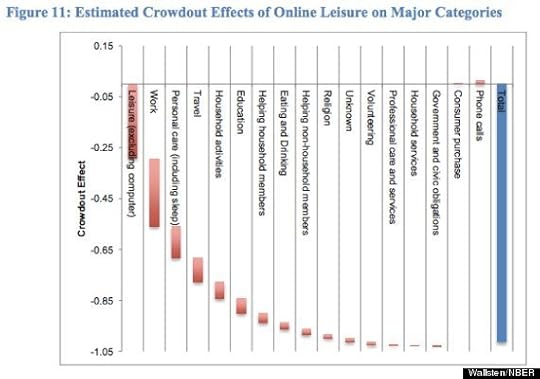
Wallsten’s findings are based on data collected from 2003 to 2011 by the American Time Use Survey, an annual poll of 13,000 Americans launched in 2003 by the Bureau of Labor Statistics and the U.S. Census. The survey aims to find “nationally representative estimates of how, where and with whom Americans spend their time.”
From 2003 to 2011, we doubled the share of free time we spent on computers from 8 minutes to 13 minutes a day, while our total daily leisure time stayed constant at about five hours.
Thirteen minutes may seem bizarrely small for online leisure, given the hours that Gmail and Netflix can consume. Indeed, because the survey tracks what we do -- not which device we’re doing it on -- email, gaming and watching YouTube videos are excluded from that total and tallied in separate categories. Those 13 minutes of computer-based leisure time include activities like search and social networking, as well as smartphone use, according to Wellsten. (A major limitation of the data, however, is it does not account for multitasking.)
The report aims to better quantify the wealth-creating potential of the Internet by probing the opportunity costs of innovation and Web services. While services like Google and Facebook may not require credit cards, they're hardly "free." As the study noted, a minute on those sites costs seconds elsewhere. For teens ages 15 to 19, an hour online means 18 fewer minutes spent on educational activities. For Americans ages 25 to 39, an hour of leisure time online comes at the expense of 20 minutes of work.
"The crowd-out effect is sufficiently large that understanding the true economic effects of the Internet must take them into account," wrote Wellsten. If not, economists are likely to "over-estimate the incremental economic surplus created by the Internet."
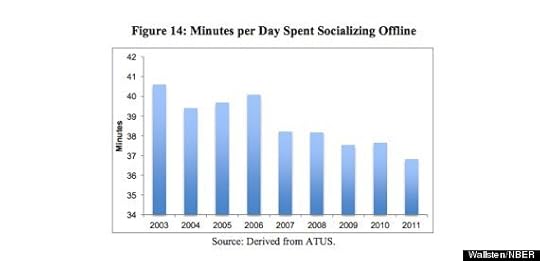
"My results also suggest that other offline leisure activities that involve interacting with other people are crowded out by online leisure: attending parties and attending cultural events and going to museums are all negatively correlated with online leisure," wrote Wallsten.
It's not only economists who should take note. Anyone who's ever questioned social media's influence on our social lives should give special attention to Wellsten's conclusions.
Even as computer-based leisure activities rise, the 13 minutes they consume each day pale in comparison to how much time we spend watching television, which still accounts for more than half of Americans’ daily leisure time.
As Wellsten noted, “What we still like to do more than anything else is sitting down and watching a screen.”
October 16, 2013
What Would Make The iPhone Magical Again
In the past several years, it's become harder to answer the latter. The iterative progression of the iPhone has prompted doubts about Apple's ability to innovate, and these questions are likely to surface again this week in the run-up to Apple's Oct. 22 press conference (though it's expected to focus on iPad news).
Although the iPhone has been at the center of talk about the increasingly mundane nature of smartphones that once seemed miraculous, the breed of devices as a whole has ceased to amaze us. All the talk of how boring smartphones have become made me want to ask some of these unimpressed smartphone owners a question of my own: If you're so bored by your phone, what do you want it to do? What would make the smartphone magical again?
We posed those questions to readers on Facebook and Twitter. It turns out that if Apple were to ask, our wish list would be wide-ranging -- from the mundane (better battery life) to the fantastic (mind-reading!).
According to a 2013 J.D. Power Associates survey of over 16,000 smartphone-toting adults in the United States, battery life was ranked the least satisfactory attribute of smartphones today, coming in dead last out of 19 different characteristics. An informal survey of HuffPost readers on Facebook confirmed phones still aren't living as long as their owners would like: Battery performance emerged repeatedly as an ongoing annoyance, while others lamented the fragility of their phones. Harriet Geoghegan, one of my Facebook followers, hoped for phones "not made of the most breakable materials imaginable."
But those features are hardly revolutionary. It's easy to imagine people yawning at a press release touting a slight bump to battery life, even if it is convenient. (Did you know there's a new phone that can get 20 hours of heavy use on a single charge? Exactly.)
Smartphone owners want their gadgets to have bigger brains, not just brawnier bodies. The smartphone we have pales in comparison to the geniusphone we're dreaming of -- one that knows when to interrupt, is carefully attuned to our subtlest cues, and anticipates what we want by paying close attention to our environment.
"I want to just look at the phone and have it know what I want to do," wrote John Hayter on Facebook. Malay Chakrabarti asked for "emotion-sensing capabilities," and Al Podboy said he'd like a smartphone that would "'ring' only for a list of 'loved ones' or emergency services/calls" in the evenings. (The iPhone's Do Not Disturb tool offers this kind of feature, though it requires some setting up). J.D. Power found the most-desired feature for future smartphones was seamless voice control: 18 percent of respondents wanted to be able to boss their phones around just by speaking to it.
Smartphones have become our most constant companions, and research suggests we'd like them to be more thoughtful ones. After all, our current smartphones give all alerts the same prominence, meaning we're constantly checking our phones to see if that vibration came from a Facebook friend request, or a text from our boss. It's easy to imagine a phone that, like a human assistant, could intelligently learn when to interrupt us with an incoming alert, and when to save a non-essential notification for later, when we've finished dinner.
More than two-thirds of smartphone users check their phones even when they haven't received any alert, a 2012 Pew Research Center survey found. The biggest annoyance for cellphone owners polled in that survey was being "always reachable" by "people bothering me" -- hinting there might be appetite for phones that can better field messages or calls, just as Podboy requested. As it is, over a third of 18- to 24-year-old cell phone owners complain that their phones have made it harder to avoid distractions and focus on a single task, according to Pew.
"The constant chirp, beep, ding, buzz and vibrate of my phone is far worse than 'mosquito buzzing in ear' syndrome. I know the Internet exists, but I don't need to be reminded of it at two-minute intervals," wrote Carine Carmy, the director of marketing at 3D printing startup Shapeways, in an email. "I'd love a phone that would be more sensitive to my context and priorities, but the responsibility is probably on me to unplug a bit more often."
More broadly, we seem keen to have our phones evolve beyond communication tools and take on new functions as control centers for our environments -- we're looking for phones capable of doing things like heating, lighting and monitoring our homes. The Nest Learning Thermostat, for example, already allows homeowners to control their thermostats via their smarpthones.
The sandwich-making, fruit-ripening, pancake-flipping and back-massaging smartphones HuffPost readers requested might be far off, but the idea of a phone that can react intelligently to signals from built-in sensors isn't so sci-fi.
"This first wave of smartphones have been more about how people communicate," said Kirk Parsons, J.D. Power's senior director of telecom services. "I think the next big leap will be about physical connection with your being and the environment outside of you." Ten percent of smartphone owners want phones to have built-in sensors that can track noise, temperature and brightness, J.D. Power's study found.
But there's another camp of people that would prefer to see the smartphone revert. In a Facebook post that received 10 "likes," Lisa Simmonds wrote, "I wish they'd melt down and become paperweights so people would start interacting with each other again."
October 11, 2013
Google's Plan To Shove You In Ads (And The Danger Of The Friendorsement)
Finally, we know what Google had in mind: It’ll be sticking us in its ads.
Google announced Friday that it will begin featuring users’ photos, names and comments in the promotions it serves up online, both on Google properties and on the more than 2 million sites that tap into its advertising network.
Ratings, reviews, relationships, comments, posts and other information taken from our activity on Google’s websites, such as Google+ and YouTube, will be repurposed and served up in these new so-called “shared endorsements.” For example, if you review Candy Crush or “+1” a steakhouse on Google+ (the equivalent of a Facebook “like”), your friends might see your picture and name show up alongside ads for that app or restaurant.
It’s clear why these personalized ads are better for Google and its paying customers. But it’s also clear that the rise of the friendorsement -- relationships repackaged as ads -- risks making our interactions online more awkward, not less. Google is taking advantage of our relationships and reputations to sweeten sponsors' pitches, transforming us into spokesmen in situations we don't always have control over. By making us into its salesforce, Google is transforming the soulmate into the sellmate.

Examples of shared endorsements, via Google.
Google is hardly the first company to try gussying up ads with our faces in an attempt to make promotions more palatable. In 2011, Facebook introduced “Sponsored Stories,” a controversial ad type that let brands use a fan’s name and photo when pitching to that person’s friends. The ad format brought in several hundred million dollars between 2011 and mid-2012 -- and a class-action suit that Facebook settled earlier this year. In August, Facebook tried again, updating its privacy policy in ways that would "allow Facebook to routinely use the images and names of Facebook users for commercial advertising without consent," privacy advocates alleged. The Federal Trade Commission is currently reviewing the proposed changes.
Unlike Facebook’s Sponsored Stories, which made participation mandatory, Google will allow its members to opt out of appearing in its digital billboards. (Find out how to do so here -- the changes will go live November 11.) Individuals who don’t explicitly revoke permission may have their likeness appear to “friends, family and others.” Users under 18 may see Google’s “shared endorsements,” but they will not appear in them. According to The New York Times, the update will affect not only the 190 million users who actively post on Google+, but also the "390 million [who] use the social network indirectly by sharing on other Google sites like YouTube," and potentially others who use Google's suite of services.
On the surface, it might not seem like such a bad idea to pair people with products in online ads. The advertisers get our attention. We get to hear what our neighbor/friend/cousin/estranged college boyfriend thinks of Brand X. The narcissists out there will also relish the additional visibility. (Google pitches the new ads as a way to “ensure that your recommendations reach the people you care about.”)
Yet in practice, the promotions aren’t always so useful. While these social networks know who we follow and friend, they’re still largely unaware of whom we trust. Given our expansive and eclectic collection of acquaintances online, we end up getting fashion suggestions from people we only trust for their nose for tech news, or restaurant recommendations from ex-roommates with abysmal taste. Just because we know someone online doesn’t mean we want -- or have any faith whatsoever in -- their opinion on what to buy.
In addition, the “+1” and “like” are watered-down terms that don't necessarily mean what tech firms assume they imply. We “like” things all the time we don’t really like, and the new ad format risks confusing an interest with an endorsement. Republicans will “like” or “+1” Obama’s page just to get his updates; friends will “like” an app because their friend asked them to. It’s awkward -- and just plain wrong -- when our names appear alongside products making it seem as if we endorse them.
But the biggest issue of all is what it may do to our relationships as we get used to seeing friends' smiling faces plastered next to mattress and hotel ads. When Google+ launched, Google criticized Facebook for devaluing the concept of "friend" with its one-size-fits-all categorization for acquaintances, colleagues and close friends. "[O]nline services turn friendship into fast food -- wrapping everyone in 'friend' paper," Google wrote in 2011. Only now, Google (and Facebook) are also morphing friendship into an efficient delivery mechanism for ads.
You can hope to be a good friend. But you'll definitely be a friendorsement.
October 8, 2013
Nest Protect Is The Politest Smoke Alarm You've Ever Met
Like Nest's Learning Thermostat, the forthcoming Nest Protect smoke and carbon monoxide alarm offers a smarter, more user-friendly take on a boring-but-functional appliance, albeit it for about four times the cost of its simpler cousins.
"We want to take things you already know and reinvent them," Fadell said of Nest's design philosophy. "We don't need new products. We need to take existing products and make them better."
Marketed with the motto, "Safety shouldn't be annoying," Nest Protect has features that make it easier to silence during false alarms and supplements the traditional strident beeping with spoken alerts and color-coded signals.

False alarm? Wave your hands to stop the beeping.
Think of it as the politest smoke alarm ever. Nest Protect's "Heads Up" function will alert homeowners to the presence of smoke or carbon monoxide before it reaches emergency levels and then allow them to dismiss the alarm with the wave of a hand. In theory, that means no more flapping dishtowels when burnt toast or a particularly smoky cut of steak set off the sensor. To indicate it has sufficient battery, the device glows green when the lights in the room are turned off. And thanks to its motion sensors, Nest can even act as a nightlight, glowing faintly when it perceives motion in a dark hallway.
Nest Protect is chattier than the typical smoke detector. Multiple units can communicate wirelessly across a home; the alarms can send alerts to homeowners' mobile phones; and they have a motherly voice they use to communicate, in addition to the typical beeps.
According to Fadell, Nest auditioned some 30 voice talents in each of the three countries where Nest Protect will be launching -- the United States, Canada and the United Kingdom -- before it found three that were the right blend of "friendly," "warm but not too warm" and "authoritative but not too authoritative."
Each Nest Protect unit will cost $129, making it one of the costlier smoke and carbon monoxide detectors currently available. The Nest Learning Thermostat, which retails for $249, is also more expensive than competing offerings. Though the latter device has won critical acclaim and a series of design awards, Nest Labs has so far declined to specify how many people have ponied up for its high-end thermostat.
The new smoke alarm is still undergoing testing by independent agencies to ensure that it meets safety standards. Nest expects it to go on sale in November.

Nest Protect as a nightlight.
October 4, 2013
Facebook Wants To Know: Do You Like Me? Do You Really Like Me?
“It stopped being this social media outlet where I could get everything,” he explains. “Instead of getting what’s of interest to me, [Facebook] has enabled a lot of things that are completely irrelevant to me into my usual feed.”
It’s people like Gomez that Facebook hopes to understand better -- and win back -- through a new research endeavor launching Friday that will focus primarily on how we feel about the stories and ads in our News Feed.
The social network regularly polls its members about their Facebook experience. Yet for the first time in the company’s history, Facebook will track how peoples’ attitudes toward the site evolve over time. Instead of getting a snapshot, the 10,000 people in Facebook’s first “feedback panel” will be surveyed monthly for six months to see how their satisfaction with the site changes and why.
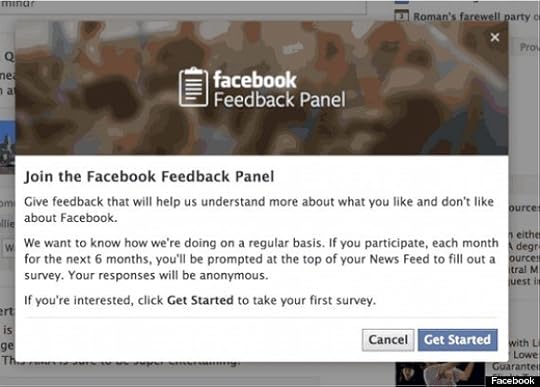
Facebook will be inviting certain members of the Facebook community to take part in the panel.
This inaugural panel will examine how the makeup of ads and stories in News Feed affect peoples’ enjoyment of Facebook, underscoring just how concerned Facebook is with ensuring its ads don't alienate its users. Ads on Facebook aren’t going anywhere; if anything, their number and type will increase. Facebook wants to learn everything it can about which ads make its members happiest -- and how far it can go in pushing promotions before people get fed up.
“We really want to understand, in-depth, how users feel about ads, so that as we grow our business, we maintain the right balance between our advertisers’ needs and the users’ experience,” said Fidji Simo, Facebook’s product manager for ads in News Feed.
Of all social media users, Facebookers are the most irritated by ads, a July 2013 report by the American Customer Satisfaction Index found. Twenty-seven percent of the Facebook members surveyed said advertising “interferes with their experience,” the ACSI research found.
Simo counters that Facebook has seen “no meaningful difference” between the satisfaction of users who do and do not see ads, a point Facebook CEO Mark Zuckerberg has stressed in previous earnings calls, as well. Still, she noted, "we don’t want to miss something.”
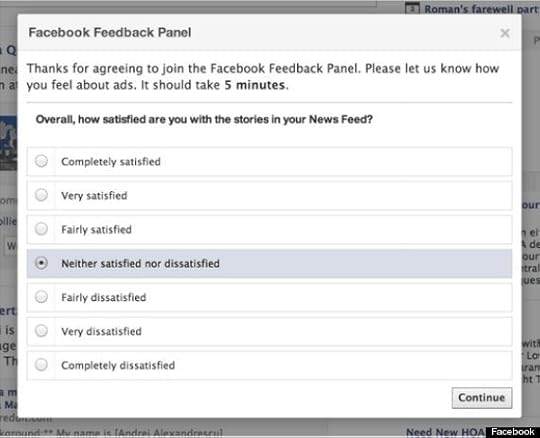
A sample question in the survey.
In addition to probing general satisfaction with Facebook, News Feed and ads, the survey includes more specific questions about whether the site feels overly commercial; if companies seem to be hogging the news feed; and how well users understand advertisers’ access to their data. Participants will also be asked if they observe variation in the quality and quantity of ads delivered to them, and how they predict their Facebook usage might change in the future.
Facebook will use the results to tweak the mix of stories and ads it pushes to News Feed. For example, if Facebook sees a group of users’ satisfaction plummet in a given month, Simo and her team would look to see what might have changed about their experience on the site. If they find those individuals had, say, received far more ads than usual, or many more in the morning, Simo would know whether to scale the ads back or try shifting more to the evening.
“The real purpose is to connect changes in attitudes over time to the experience which might be driving those changes,” explained Judd Antin, a user experience researcher at Facebook who helped develop the feedback panels.
Simo notes the survey also allows Facebook to investigate differences between how individuals perceive what they saw, and what actually showed up on their screens. A group that thinks it saw a bump in ads might simply have been seeing more updates from brand pages they subscribe to, and confused that content with promoted posts.
“We do see a mismatch sometimes between what users’ perception is and what we actually did, which points to other parts of the Facebook experience we have to fix,” said Simo. “It’s always interesting to compare perception and reality because what really matters, at the end of day, is perception.”
The first feedback panel will be limited to English-speaking users in the United States, though it will include a cross-section of people who are representative of Facebook’s U.S. population as a whole. In addition to tapping individuals from different ages and genders, Facebook will also look to recruit people who are more active and less engaged; new members and older veterans of the site. Simo noted that other groups in Facebook have expressed an interest in the longitudinal research work, and might adopt the panel approach themselves.
While the other billion-or-so people who aren’t on the panels will be seeing changes as a result of what Facebook learns from the surveys, here’s something they won’t get access to: the results of the questionnaires. Though Facebook likes it when people share, the company itself seems less inclined to do so.
October 3, 2013
Here Are The 22 Coolest Tweets Ever, According To Twitter
But only a handful those tweets merited inclusion in the IPO documents. As you might imagine, the tweets that were included were heavy on ads, and light on spambots masquerading as porn stars. Still, as the Wall Street Journal notes, Twitter may be the only company to include Osama Bin Laden in its IPO filing.
We've collected Twitter's favorite tweets -- or at least the ones it thinks will help them make money.
Here are the tweets Twitter considers worth celebrating:
Obama's election:
Four more years. pic.twitter.com/bAJE6Vom
— Barack Obama (@BarackObama) November 7, 2012
Osama bin Laden raid:
Helicopter hovering above Abbottabad at 1AM (is a rare event).
— Sohaib Athar (@ReallyVirtual) May 1, 2011
Hurricane Sandy:
Just advised that national guard has arrived in Hoboken. More to come.
— Dawn Zimmer (@dawnzimmernj) October 31, 2012
In Hoboken, we have 20 vehicles and 6 box trucks w boxed lunches, ready-to-eat meals, water, 7 mental health workers
— American Red Cross (@RedCross) November 1, 2012
(11.1.12) #Sandy
NYC Tap Water is absolutely safe to drink #SandyNYC #Recovery
— Mike Bloomberg (@MikeBloomberg) November 1, 2012
US Airways Flight 1549 lands on Hudson River:

Mario Batali trades tips with singer Gavin Rossdale:

Twitter co-founder Jack Dorsey's first tweet:
just setting up my twttr
— Jack Dorsey (@jack) March 21, 2006
Water ice found on Mars:
Are you ready to celebrate? Well, get ready: We have ICE!!!!! Yes, ICE, *WATER ICE* on Mars! w00t!!! Best day ever!!
— MarsPhoenix (@MarsPhoenix) June 20, 2008
An Everest climb live-tweeted:
I've left 7500m camp for Everest summit push on 10:30pm JST. It's really cold, dark and like space. I can only see stars.
— Nobukazu Kuriki (@kurikiyama_EN) October 17, 2012
Oreo's infamous Super Bowl tweet
Power out? No problem. pic.twitter.com/dnQ7pOgC
— Oreo Cookie (@Oreo) February 4, 2013
Royal baby is born:
Her Royal Highness The Duchess of Cambridge was safely delivered of a son at 4.24pm
— Clarence House (@ClarenceHouse) July 22, 2013
Kevin Durant plays flag football:
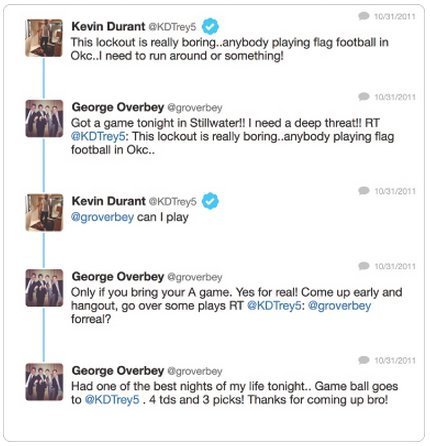
New Relic ad:

Wheat Thins Vine ad:
Have Your Wheat Thins Been Taken? Probably.
— Wheat Thins (@WheatThins) April 23, 2013
http://t.co/IRLWBSrwFR
#MustHaveWheatThins
http://t.co/bDfzwmka9K
Bonobos Twitter sale:
TWIXCLUSIVE Sale! Our 1 and only Washed Chinos. Were $88, now $49. 24-hour sale unlocks after 49 RTs. http://t.co/9xBB0lPQ
— Bonobos (@Bonobos) September 29, 2011
October 2, 2013
Facebook Study Reveals Links Between What You Post And Who You Are

Researchers have confirmed what we've suspected all along: Parents and teens really do speak different languages online.
But so do introverts and extroverts; men and women; the neurotic among us; and the well-balanced.
The journal PLOS ONE has just published the results of the largest study to-date of personality and language. The findings offer an unprecedented look at how differences in age, gender and temperament affect how we communicate on social media.
Using over 15 million messages posted by 75,000 Facebook users, researchers at the University of Pennsylvania were able to find which words, phrases and topics correlated most closely with certain personalities and demographics.
Females were more likely to use the word "excited," the study found; males more commonly used "f*ck." Those ages 19 to 22 discuss getting "drunk," while 23- to 29-year-olds opt for "drinking beer."
"[T]aken all together, these word clouds provide an unprecedented window into the psychological world of people with a given trait,” said Johannes Eichstaedt, the study's co-author, in a press release.
The vast data available via Facebook allowed the researchers to take an "open vocabulary" approach to their analysis: Instead of comparing the frequency with which different groups used a predetermined set of words, they could instead "[derive] important words and phrases from the sample itself," the press release noted.
What You Say If You're 15 ;)
On Facebook, teens' language is dominated by emoticons, references to school and interjections like "ugh" and "bleh." Twenty-somethings graduate to discussing classes, semesters and "sh*t," and people in their mid-20s tend to discuss weddings, days off and being at work. For individuals between ages 30 and 65, family dominates discussions. (See the word cloud above.)
Here's additional proof of the age divide between the "me" generation and the "we" generation -- and more fodder for fears that young people are narcissistic online:

Complaining also decreases with age. As people get older, their Facebook posts contain fewer instances of "freakin annoying" and more talk of "loving," "caring," "honest" "family" and "friends."

Introverts Post About The Internet, Extroverts Post About Parties
Different personality types gravitate toward different words and topics, the study found. Extroverts were more likely to discuss "chillin" and "parties," and introverts were in turn more focused on solitary activities, like "manga," "anime" and "computer." The researchers also highlighted a connection between "emotionally stable" individuals and their tendency to discuss social activities, such as sports and vacations, which they suggested might "foster greater emotional stability."
Researchers said that the study's results offer a glimpse at the world through others' eyes.
“When I ask myself, 'What's it like to be an extrovert?’ ‘What's it like to be a teenage girl?’ ‘What's it like to be schizophrenic or neurotic?’ or ‘What's it like to be 70 years old?’ these word clouds come much closer to the heart of the matter than do all the questionnaires in existence,” said Martin Seligman of the University of Pennsylvania's Positive Psychology Center.

He Says, She Says
In an email, H. Andrew Schwartz, one of the study's co-authors, stressed that the study's findings do not highlight the topics discussed most among the average male or female, but rather the expressions that set them apart.
"Most male and female language is the same," he wrote. "In fact, if those word clouds were just based on frequency, they would look nearly identical. Our quantitative analyses are designed to find the differences."
The researchers' model was able to predict an individual's gender from their language patterns with 91.9 percent accuracy, the study noted.

September 26, 2013
Twitter Hoax Reveals What We Desire Most From Machines
For years, @Horse_ebook’s over 200,000 avid followers had been convinced its sometimes poetic, often nonsensical, frequently hilarious tweets had been the musings of a spambot created to elude Twitter’s spam detectors and peddle books about horses. There was something captivating about an algorithm that seemed so gifted at capturing the conundrums of our age. (“Everything happens so much” read one post, retweeted 8,500 times.)
On Tuesday, that fantasy came crashing down. The New Yorker’s Susan Orlean revealed that two living, breathing homo sapiens had been composing the tweets as an art piece.
The disappointment that followed this crushing news stemmed in part from an indignation at having been fooled, and in part from the letdown at learning such witticisms had stemmed from people. We were rooting for the robot. We loved the idea that something we thought was meant to be a nuisance -- to sell us things -- could be so charming. Here, finally, was an algorithm that wasn’t just efficient, but actually was weirdly insightful.
Our dismay at finding that the bot was human actually reveals a great deal about we want from our devices: We're rooting for the compassionate computer.
"If people are upset that [@Horse_ebooks] is a person, it's because they were hoping for the future. They were hoping that in the future, computers would be not just responsive or smart, but poetic," says Blade Kotelly, a lecturer at the Massachusetts Institute of Technology and an expert in user-interface design. "[The computers] wouldn't just be executing. They'd be thoughtful, taking care of us."
The conventional view of technology pits humans and electronics as antagonists, with robots and software always angling to replace or destroy us. To a large extent, we assume we should fear computers that become more capable. They’ll take our jobs, wed our lovers and overthrow us.
But the reaction to @Horse_ebooks' ousting highlights a different side to our relationship with technology: It shows just how much many of us like talking to machines.
Though @Horse_ebooks was fake, machines don't need a human puppeteer to be charming. History is full of bots that have charisma and appeal to us as more than mere tools. (Of course, it goes without saying that there are plenty of maddening ones too. Just call any automated helpline.)
In 1966, the Eliza chatbot, which imitated a psychotherapist in its text-based conversation, proved so enthralling to its human users that it alarmed its creator. Computer scientist Joseph Weizenbaum's subsequent writings warned of the ills that might follow from our overreliance on technology. In the early 2000s, the AOL Instant Messenger bot SmarterChild amassed 30 million “buddies” and fielded over a billion IMs a month -- despite the fact it was little more than a Magic 8 ball that could type. More recently, Siri has charmed us with its snappy answers, elementary chatbots have been used to generate scripts for films, and boxy robots have proven capable interviewers on camera.
Just last week, artificial intelligence experts convened in Ireland for the Loebner Prize, a competition to see who could create the most human-like chat bot. A group of teenagers who helped judge the competition said they could tell easily which chatting partner was a person and which was a machine. But who was most fun to talk to? Definitely the chatbot, they agreed, according to one of the contest’s attendees. The bot that won, Mitsuku, had been built to draw visitors to a music website -- only its creator found that people preferred speaking with the bot to listening to the tunes.
So what’s so entertaining about bots with personality? Why do we willingly engage in conversations with computers, even though we know they’re nothing but code? And what makes their accidental wit so charming?
In part, it’s the sheer novelty of it. Clever humans have been around for millennia. Humorous computers, on the other hand, are still the stuff of science fiction. Even in their simple forms, conversations with witty algorithms can feel like the future, a kind of teaser of robo-companions to come.
After all, we’ve spent centuries dreaming of machines that can equal our capabilities. And for centuries, we’ve been duped by humans mimicking machines. The fascination with @Horse_ebooks, and subsequent disenchantment, closely resembles another mechanical illusion that captivated the world in the late 18th century. In 1770, the Hungarian inventor Wolfgang von Kempelen created what he claimed was a robotic chess-playing machine, the "Turk," that delighted Hungarian royalty and traveled around the world taking on opponents, such as Napoleon Bonaparte and Benjamin Franklin, This “mechanical” Turk, it turned out, was a hoax. Like @Horse_ebooks, a human had been manning it all along.

A recreation of Kempelen's Turk. Photo via Wikipedia user Carafe.
And like @Horse_ebooks, the 18th century automaton let us explore the possibilities of technology and help us acclimate to what the future might bring.
“Then, as now, many people were ambivalent about the new machines. On one hand, they were fascinated […] but they were also concerned that humans might end up being superseded,” author Tom Standage writes in an adaptation of “The Turk: The Life and Times of the Famous Eighteenth-Century Chess-Playing Machine,” published in Wired. “In the end, the Turk was taken seriously because it provided a starting point for discussion of the promise -- and limits -- of machinery.”
But our current bots do more than tease the future. What has attracted us to them is also the version of the future they present. In many cases, they offer a more optimistic view of what’s to come. They hint that the next generation of technology could be at once functional, emotional and philosophical: Algorithms might not be cold, unfeeling bots -- but funny companions that are agreeable to be around. Because we’re drawn to these bots, it seems this is also what we want. Technology that’s a bit heart, and a bit code.
People who take pleasure in chatbots, or agents like Siri, are “looking for something you don’t expect from a computer,” says Richard Wallace, chief science officer of PandoraBots, a site that hosts and creates chatbots. “You think of a computer as something that will give you accurate, truthful, emotionless information. They’re looking to test it out and see … if these apps can give the impression of having feelings or being alive somehow.”
We’re hoping our bots will cut loose. They need to live a little -- but not be alive.
September 20, 2013
These Are The People Who Are Quitting Facebook
Researchers at the University of Vienna have just published the results of a study examining the temperament and demographics of the people who leave Facebook, shedding light on what distinguishes those who commit “virtual identity suicide” from the rest of us still enduring the “pokes.”
The team surveyed 310 people who had quit Facebook and 321 Facebook members on their personality traits, Internet addiction tendencies and attitudes toward privacy to see if certain patterns would emerge. The respondents consisted of people from all over the world who were recruited online and volunteered to take the study, though they're a small sample compared to the entirety of Facebook users and are not necessarily representative of all Facebook quitters.
According to those surveyed, it turns out that the people who leave Facebook aren’t so different from the rest of us. They’re also worried about who sees their photos, annoyed by Facebook’s constant changes, irritated by superficial social interactions and concerned by how many hours they spend glassy-eyed and slack-jawed staring at their screens.
And even among those who haven't quit Facebook, a large number say they've considered it. Nearly half (46.8 percent) of the current Facebook users surveyed said they’d previously considered quitting the site. A full 61 percent of members say they've taken extended breaks from Facebook, lasting several weeks or more, according to a report from the Pew Research Center published this year.
Yet the University of Vienna study did find several key attributes that characterized those who'd killed off their Facebook accounts:
- They’re more likely to be men: Among those who had deactivated their accounts, the majority (71.5 percent) were male. Among those who currently used Facebook, the majority (70.5 percent) were female.
- They’re slightly older: The average age of the individuals who’d quit Facebook was 31, while the group still using Facebook was 24 years old, on average.
- They’re more worried about privacy: People who had deactivated their Facebook profiles exhibited “significantly higher general concern about privacy,” as measured by their score on a privacy questionnaire.
- They’re more conscientious: There were few personality differences between the Facebook quitters and keepers, with members of both groups equally extraverted, agreeable, neurotic and “open to experience.” The only difference? Conscientiousness was higher among quitters -- a small wonder given that it’s correlated with behaviors like being diligent, planning ahead and staying on task.
- They’re (slightly) more hooked on the web -- but so is everyone: Facebooking individuals had slightly lower Internet addiction scores than their non-Facebooking counterparts, yet both groups were heavy Internet users. “[I]ndividuals of both samples already showed signs of frequent problems due to Internet usage,” the paper observed.
- They had fewer friends: Facebook quitters had left behind an average of 133 Facebook friends, or about half as many as ongoing Facebook members, who had an average of 349 friends. (A poll by Edison Research, a market research firm, found the average Facebook user had 303 friends.)
- Their tenure and time on the site is no different: The amount of time quitters and members spent on Facebook didn’t vary much (1.9 hours a day and 1.8 hours a day, respectively). They'd also had their accounts for almost exactly the same amount of time (an average of 26 months for quitters, and 29 months for members).
Not surprisingly, concerns over privacy topped the list as the most popular reason for quitting Facebook. Forty-eight percent of those who'd left the site said they were motivated to leave because they had reservations about how their personal information was being used, while 13.5 percent cited a “general dissatisfaction” with Facebook, 12.6 percent left because of “negative aspects of online friends,” and six percent felt they were growing addicted to the site. (Respondents were able to list their reasons in an open-ended response.)
Facebook declined to comment.
Other research has shown that leaving Facebook has also become a kind of status symbol, much like refusing to own or watch TV.
"Many Facebook refusers actually revel in their difference from the mainstream, seeing it as a mark of distinction, superior taste, and identification with an elite social stratum," wrote New York University assistant professor Laura Portwood-Stacer in her study of Facebook quitters published last year.
Given how many people said they’d considered leaving Facebook, here's a possible follow-up study for the team in Vienna: What defines those who choose to stay on the social network? Why are they still there?



